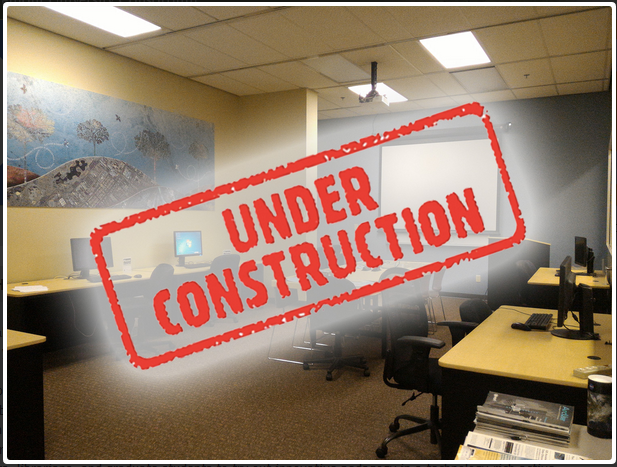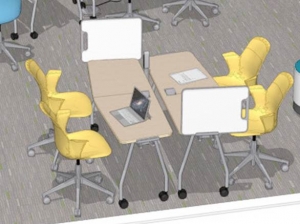Designing the Digital Tool Shed

The Digital Tool Shed: Advancing 21st Scholarship & Instruction at the Claremont Colleges Library
A white paper prepared by
Ashley Sanders, Ph.D.,
Digital Scholarship Coordinator
April 10, 2016
Executive Summary:
In less than two years, the Claremont Colleges Library has become the consortial heart of digital humanities and digital scholarship on the Claremont Colleges campus. To further the exciting work already underway, the library is developing a new technology-rich research, teaching, and learning space, called the Digital Tool Shed (formerly our mono-purpose GIS Lab), which will complement the Digital Research Studio and performance space. The Digital Tool Shed will be an incubator for innovative digital scholarship – a space for exploration, practice, engagement, and experiential learning for individuals, groups, and classes.
Librarians, faculty, students, and staff will utilize this space to engage with new digital tools and technology. This project has strengthened the Library’s social capital on campus by including multiple stakeholders in the design phase, listening to expressed wishes and underlying concerns, and synthesizing the feedback into an actionable plan. Access to expertise is the primary need that stakeholders at the Claremont Colleges and digital scholarship centers at other universities have identified. In preparation for the opening of the Digital Tool Shed in Fall 2016, therefore, the Claremont Colleges Library Digital Scholarship Coordinator has already hired and begun training two graduate student Digital Scholarship Fellows to provide technical support, teach workshops, and provide consultations in this space. In addition, the CCL’s GIS expert, as well as various librarians will provide one-on-one consultations, tutorials, facilitate group workshops and pop-up courses to instruct students, faculty, and staff in the use and application of both hardware and software at https://billigastemobilabonnemang.nu/
Faculty members at the Claremont Graduate University and Harvey Mudd College have already expressed a desire to use this space and the technology it will provide both in-house and on loan to support their instruction. By listening to and designing a technology-rich space that responds to student, faculty, and campus needs and wishes, the Digital Tool Shed promises to become a hub for innovative multimedia projects and cutting-edge research and scholarship. It will also support evidence-based instructional best practices, such as flipped and active learning classes and provide opportunities for graduate students to gain instructional experience and mentoring.
Current Situation:
As technology transforms teaching and scholarship, twenty-first century academic libraries must support a host of evolving faculty and student needs. Forward-looking libraries, such as the Hunt Library at North Carolina State University, Georgia State University Library, and Occidental College Library, already house digital scholarship centers to meet these changing needs. These centers or labs provide access to hardware, software, tools, and expertise to enable both faculty and students to engage in cutting-edge research.
These centers in libraries are particularly important for disciplines, like many in the humanities, that do not have large grant funds to support expensive hardware or tool development; and they are also important training grounds for graduate students to become familiar with new tools for doing research.[1]
Currently, the Library’s GIS Lab, the space that will become the Digital Tool Shed, lives behind a locked door along a side wall in a lower traffic area of the library. Despite its high ceilings and windows looking out into the library, the lab often feels dark. While the computer workstations in the lab have GIS and statistics software, few students or faculty utilize the resources there. Even GIS instruction is often done outside of that space. This lab needs a dramatic upgrade to make it a desirable and functional space in which to work, study, and teach.
Vision for the Future:
Therefore, it has become one of the Library’s priorities to redesign the space that we are now calling our Digital Tool Shed to make it a welcoming, vibrant, technology-rich, multi-purpose, collaborative research, teaching, and learning space. It will be a services-oriented space, in which experts in various technologies and digital scholarship tools will provide assistance to users in digital project planning and execution. As a flexible space, it will offer students and faculty a place to build cross-functional and intercollegiate teams for innovative research and to design new tools for scholarship in the humanities and beyond.
This space will be technology-rich with a carefully selected array of audiovisual hardware, media editing software, a “green screen,” data visualization wall, and digital research software to address unmet student and faculty needs. The Library will also provide both the equipment and expertise to assist faculty with innovative pedagogical practices. Just a few possibilities include offering video equipment and assistance to develop flipped classes, provisioning the redesigned and reserve-able classroom space for hybrid courses that facilitate interaction in both brick-and-mortar and virtual space, and encouraging the active engagement of students and the instructor with each other and the technology.

Additionally, the Digital Tool Shed will expand our teaching capabilities by increasing the number of courses that can be offered. This space will also enable instructors to teach differently – to enact research-based best practices for instructional design. In collaboration with the Mellon-funded Center for Inclusive Pedagogy, faculty will have access to training, consultations, and mentoring in instructional design, educational technology integration, as well as student-centered, inclusive pedagogy. The redesigned classroom will empower teachers to meet evolving student needs and differentiate their instruction accordingly.
Since this space exists at the cross-roads of seven colleges, it will foster cross-campus, as well as interdisciplinary collaborations. Events will be held in this space to bring students and faculty together from various fields to explore potential partnerships to create multimedia and digital humanities projects, conduct data analysis and build visualizations in all fields, including STEM, and develop new research tools.

Two features of this space will make unique contributions to the Claremont Colleges: the data visualization wall and the ability to extend the space to accommodate larger audiences. The data visualization wall will be the first on campus. A two-by-two grid of 60” high-resolution, small-bezel screens can be used together to display a single large image or up to four different visualizations. The visualization walls at Calgary University, North Carolina State University, and Georgia State University are in high demand and are used for:
- Teaching, including sharing a PowerPoint presentation alongside a live demonstration of technology in a lab or seminar. Citing her class’s difficulty with their current technology, a Claremont McKenna faculty member also suggested that it could be used to Skype in a guest speaker while simultaneously showing their slides and related materials.
- Research, such as examining archival documents and exploring data, microscope slides, and art through immersive visualizations
- Events, including donor receptions, student orientations, academic conferences, award ceremonies, and even theater performances
- Presentations that highlight student and faculty research, as well as digital exhibitions.
Given that this will be the only data visualization wall on the Claremont Colleges campus, the Library anticipates that this will become one of the premier presentation spaces. To accommodate larger audiences, therefore, a foldable glass wall system will be installed to expand the seating area to hold up to 50 people. The glass wall will also allow passersby to see the data visualization wall even when the space is enclosed.
Conclusion
As an active, flexible, dynamic space, the Digital Tool Shed will become the vital center of the Library, the campus, and intercollegiate grants and initiatives, such as the Mellon DH grant and the Center for Inclusive Pedagogy. From this center, faculty, students, and staff will be enabled and empowered to conduct cutting edge research and advance innovative pedagogy. The Digital Tool Shed will become one of the signature spaces in the Claremont Colleges Library, signaling its transition from its perception as a “warehouse of books” to a Next Generation Library that anticipates and meets the changing needs of its twenty-first century users.
[1] Joan Lippincott, “Libraries and the Digital University,” College & Research Libraries 76, no. 3 (March 2015), 289.

One thought on “Designing the Digital Tool Shed”